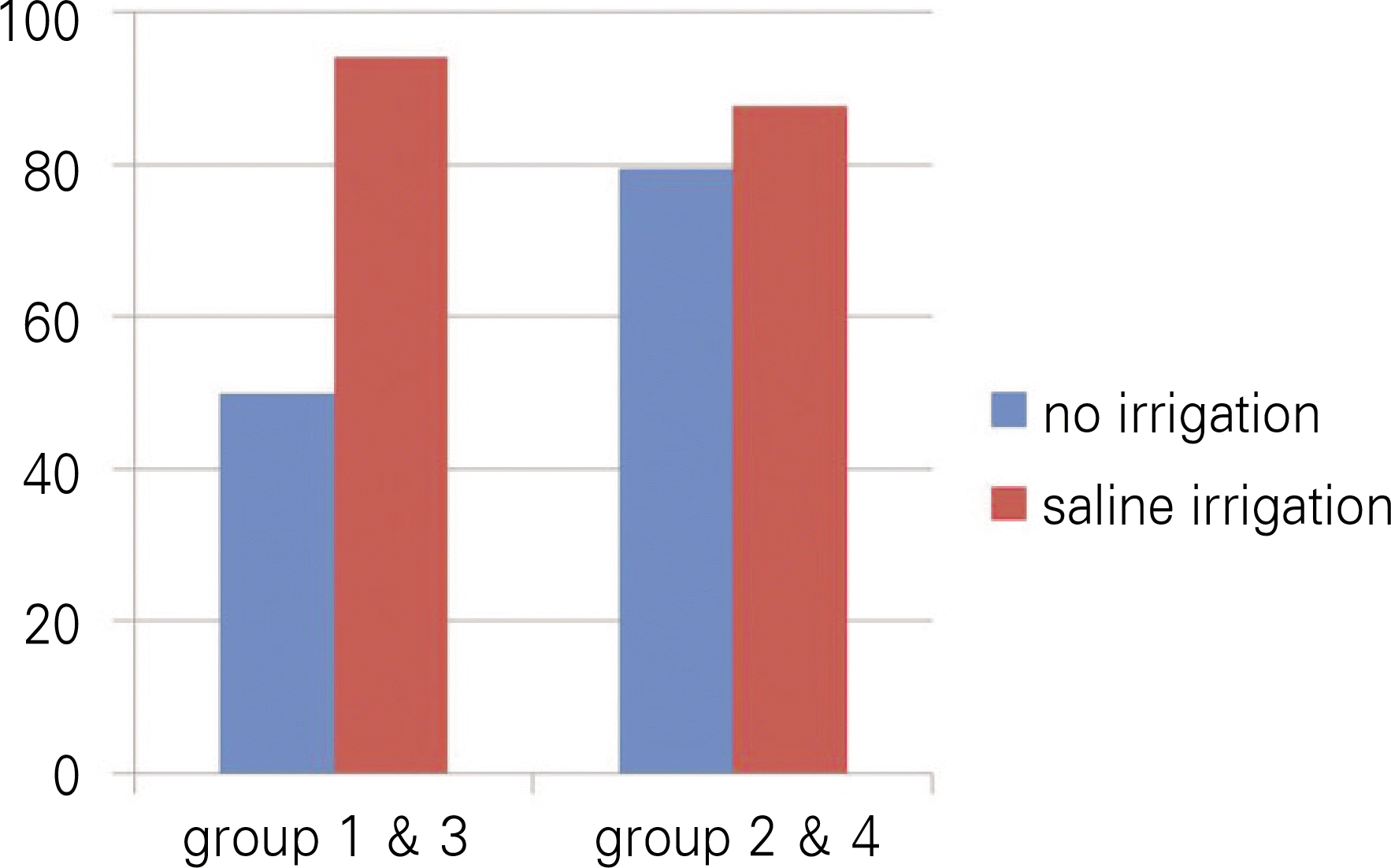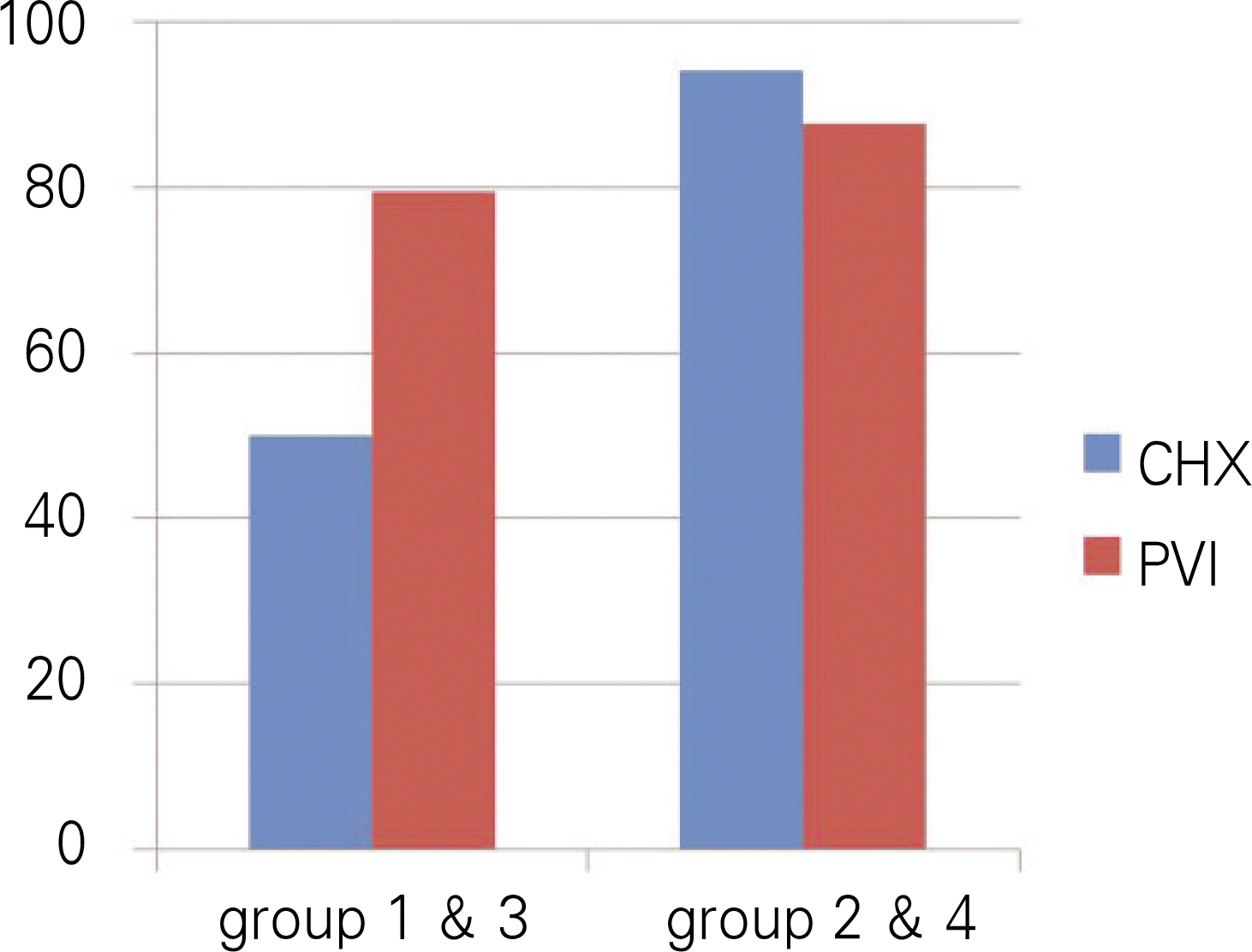Abstract
Introduction
The aim of the present study was to investigate the effect of mechanical irrigation in combination with mouthwash of antimicrobial agents on salivary bacterial counts.
Materials and Methods
This study was performed with a randomized study employing a panel of 40 healthy volunteers (20 males and 20 females) between the age of 26 and 32 years. Volunteers were randomly put in one of four treatment groups. In the first group, 0.2 mL of non-stimulatory saliva was collected from every subjective person. Then, saliva was collected after rinsing with chlorhexidine (CHX) for 1 minute. In the second group, non-stimulatory saliva was collected, and then saliva was collected after rinsing with CHX and irrigation with saline. In the third and fourth groups, the same procedures as the first and second groups were performed with povidone iodine (PVI) instead of CHX. All of these samples were cultured for 48 hours aerobically. The reduction rates of colony-forming units (CFU) were calculated for each group. The reduction rate between each group was tested statistically using student t-test.
Results
Using CHX in combination with saline irrigation showed a significant decrease of the salivary bacterial CFU when compared with only using CHX.(P<0.01) And using PVI with saline irrigation showed a little decrease of the CFU when compared with only using PVI, but there was no statistical significance.(P>0.01)
Go to : 
References
1. Addy M, Jenkins S, Newcombe R. The effect of some chlorhexidine-containing mouthrinses on salivary bacterial counts. J Clin Periodontol. 1991; 18:90–3.

2. Grossman E, Meckel AH, Isaacs RL, Ferretti GA, Sturzenberger OP, Bollmer BW, et al. A clinical comparison of antibacterial mouthrinses: effect of chlorhexidine. phenolics and sanguinarine on dental plaque and gingivitis. J Periodontol. 1989; 60:435–40.
3. Santos A. Evidence-based control of plaque and gingivitis. J Clin Periodontol. 2003; 30(Suppl 5):13–6.

4. Toma ′ s I, Alvarez M, Limeres J, Toma ′ s M, Medina J, Otero JL, et al. Effect of a chlorhexidine mouthwash on the risk of postex-traction bacteremia. Infect Control Hosp Epidemiol. 2007; 28:577–82.

5. Herrera D, Rolda ′ n S, Santacruz I, Santos S, Masdevall M, Sanz M. Differences in antimicrobial activity of four commercial 0.12% chlorhexidine mouthrinse formulations: an in vitro contact test and salivary bacterial count study. J Clin Periodontol. 2003; 30:307–14.
6. Shelanski HA, Shelanski MV. PVP-iodine: history, toxicity and therapeutic uses. J Int Coll Surg. 1956; 25:727–34.
7. Nagatake T, Ahmed K, Oishi K. Prevention of respiratory infections by povidone-iodine gargle. Dermatology. 2002; 204(Suppl 1):32–6.

8. Matsumoto K. Respiratory infections-pathogenesis of acute and chronic infections. Kekkaku. 1996; 71:477–94.
9. Rahn R, Adamietz IA, Boettcher HD, Schaefer V, Reimer K, Fleischer W. Povidone-iodine to prevent mucositis in patients during antineoplastic radiochemotherapy. Dermatology. 1997; 195(Suppl 2):527–34.

10. Kim SY, Noh KP, Kim HK, Kim SG, Kook JK, Park SN, et al. Salivary bacterial counts after application of povidone-iodine and chlorhexidine. J Korean Assoc Oral Maxillofac Surg. 2009; 35:312–5.
11. Chaves ES, Kornman KS, Manwell MA, Jones AA, Newbold DA, Wood RC. Mechanism of irrigation effects on gingivitis. J Periodontol. 1994; 65:1016–21.

12. Francetti L, del Fabbro M, Testori WT, Weinstein RL. Chlorhexidine spray versus chlorhexidine mouthwash in the control of dental plaque after periodontal surgery. J Clin Periodontol. 2000; 27:425–30.

14. Davies RM, Jensen SB, Schiott CR, Lo ¨e H. The effect of topical application of chlorhexidine on the bacterial colonization of the teeth and gingiva. J Periodontal Res. 1970; 5:96–101.

15. Shiloah J, Hovious LA. The role of subgingival irrigations in the treatment of periodontitis. J Periodontol. 1993; 64:835–43.

16. Santos S, Herrera D, Lo ′ pez E, O'Connor A, Gonza ′ lez I, Sanz M. A randomized clinical trial on the short-term clinical and microbiological effects of the adjunctive use of a 0.05% chlorhexidine mouth rinse for patients in supportive periodontal care. J Clin Periodontol. 2004; 31:45–51.

17. Gershenfeld L. Povidone iodine as topical antiseptic. Am J Surg. 1957; 94:938–9.
18. Adamietz IA, Rahn R, Bo ¨ttcher HD, Scha ¨fer V, Reimer K, Fleischer W. Prophylaxis with povidone-iodine against induction of oral mucositis by radiochemotherapy. Support Care Cancer. 1998; 6:373–7.

19. Block C, Robenshtok E, Simhon A, Shapiro M. Evaluation of chlorhexidine and povidone iodine activity against methicillin-resistant Staphylococcus aureus and vancomycin-resistant Enterococcus faecalis using a surface test. J Hosp Infect. 2000; 46:147–52.

20. McLure AR, Gordon J. In-vitro evaluation of povidone-iodine and chlorhexidine against methicillin-resistant Staphylococcus aureus. J Hosp Infect. 1992; 21:291–9.

21. Lo ¨e H, Schiott CR. The effect of mouthrinses and topical application of chlorhexidine on the development of dental plaque and gingivitis in men. J Periodontal Res. 1970; 5:79–83.
22. Yoneyama A, Shimizu M, Tabata M, Yashiro J, Takata T, Hikida M. In vitro short-time killing activity of povidone-iodine (Isodine Gargle) in the presence of oral organic matter. Dermatology. 2006; 212(Suppl 1):103–8.
Go to : 
 | Fig 1.A comparison of the reduction rate of the number of colony-forming units between groups in combination with and without saline irrigation. |
 | Fig 2.A comparison of the reduction rate of the number of colony-forming units between groups using CHX and PVI. (CHX: 0.2% chlorhexidine, PVI: 10% povidone iodine) |
Table 1.
Experimental group
| Groups | Number of subjects | Antiseptic solutions | Irrigation with normal saline |
|---|---|---|---|
| 1 | 10 | CHX | — |
| 2 | 10 | CHX | ○ |
| 3 | 10 | PVI | — |
| 4 | 10 | PVI | ○ |




 PDF
PDF ePub
ePub Citation
Citation Print
Print


 XML Download
XML Download